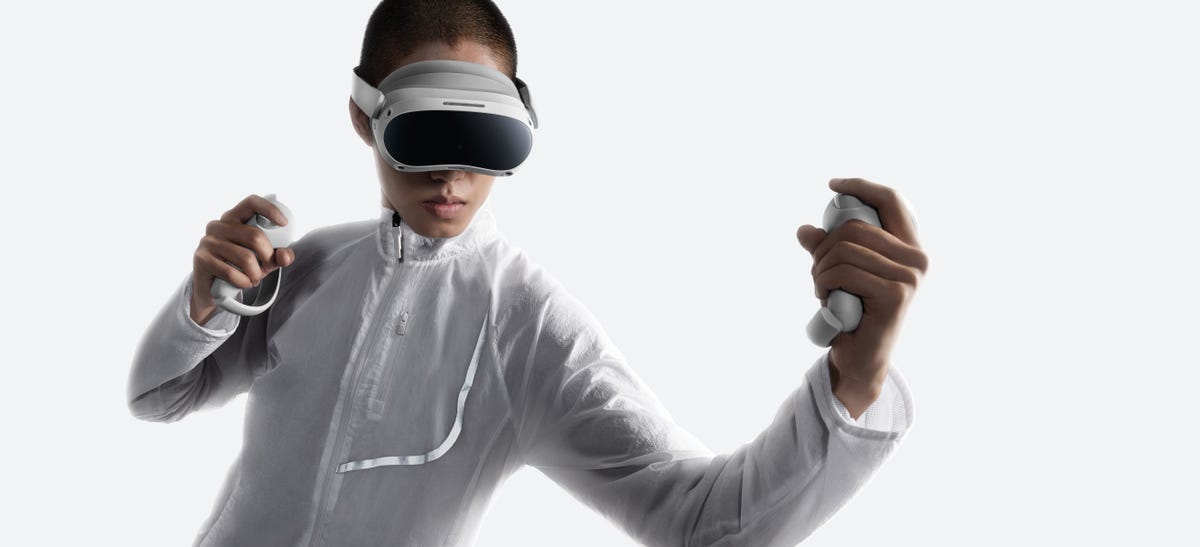When it comes to standalone VR headsets, the Meta Quest 2 has been in a class of its own for a while. That could be changing, though, if the new Pico 4 VR headset, arriving in European and Asian markets later this year, is an indicator of what’s to come. The Pico 4 goes for a similar type of standalone VR experience as the Quest 2, with a similar price. But while Meta has its own hills to climb if it wants the public’s trust, TikTok parent company ByteDance isn’t exactly much better off.
The Pico 4 looks like a better product on paper than the Quest 2 as far as hardware design is concerned. The standalone headset uses a similar Qualcomm Snapdragon XR2 chip to power its games and apps as the Quest 2 and also comes with either 128GB or 256GB of storage, the display and controllers sound like an upgrade.
The price is competitive
The Pico 4 is priced at 429 euros for the 128GB model and 499 euros for 256GB version. It’s won’t be available in the US, but the starting price converts to roughly $425, £375 or AU$640. This undercuts the Meta Quest 2, which starts at $400 (or 450 euros) for the same storage options. The headset, which is available starting Oct. 18, is coming to 13 European countries and Japan and Korea at first. ByteDance doesn’t have any plans to release the Pico 4 in the US in the future, instead opting for a business-focused pro-level version with eye tracking arriving next year.
Display looks like an upgrade over Quest 2
The Pico 4 uses a slimmer “pancake optics” system that slims the goggle part of the headset down, a feature that Meta’s upcoming Cambria pro-level VR headset is expected to adopt. The Pico 4’s better-than-Quest 2 features include a 105-degree field of view, 2,160×2,160-pixel resolution per eye LCD display and a motorized multilevel way to adjust eye distance (IPD, or interpupillary distance) with greater range. There’s also a color passthrough camera that allows you to see the outside world while wearing the headset, as opposed to the black-and-white passthrough camera on the Quest 2.


The Pico 4 controllers have a similar grip style to the Quest 2, but promise better vibrating haptics.
PicoControllers promise extra haptics
The controllers, which look similar to the Meta Quest 2 ones, promise better vibrating haptics. I haven’t tried them, but the range of vibration effects could be a lot more evolved than the Quest 2. (Whether they’ll compare with the excellent PlayStation VR 2 haptics remains to be seen.)
Fitness band extras, wireless dongles for PC play
The Pico 4 has a few extra accessory perks: a set of fitness tracker bands with three-degree motion sensors are designed to combine with fitness apps and games, tracking hands or feet in a way that sounds similar to HTC’s Vive Trackers. It’s unclear how many apps and games will use these trackers, which are expected in 2023 along with a wireless dongle to offer dedicated wireless gaming on PCs via SteamVR.
The Pico VR OS has its own fitness-tracking app similar to what Meta has, and some fitness apps already on the platform. The idea of additional body-tracking bands sounds interesting, though, and is something Meta surprisingly hasn’t adopted yet.
The Pico store: Familiar games and fitness apps, but is it enough?
The Pico 4, much like the Quest 2, has its own proprietary app store, although it could also be used with a PC to play SteamVR games. Pico’s available games and fitness apps include some Quest 2 greatest hits including Demeo, The Walking Dead: Saints & Sinners, and Les Mills BodyCombat. However, Meta has acquired a number of the studios behind the Quest 2’s most popular games, so Beat Saber and others aren’t available.
Pico’s promised avatar-based social world, called Pico World, isn’t arriving until next year, but it’s hard to tell how it’ll be any better than what Meta has promised with Horizon. The popular Roblox-like metaverse app Rec Room will be ported over to the Pico 4, though.
Is this the start of more VR headsets to come?
Pico’s been a chip partner with Qualcomm for years, but the price and design of the Pico 4 seem to be suggesting that what Meta did with the Quest 2 could be replicated. Will 2023 see more VR headsets arriving to compete with the Quest 2? Right now, the Pico 4 stands as the closest standalone competitor. But maybe, just maybe, this could also be a sign of the start of more.


